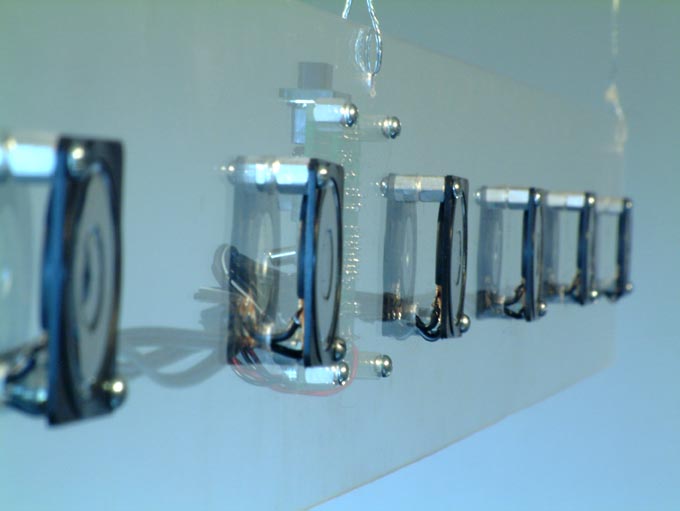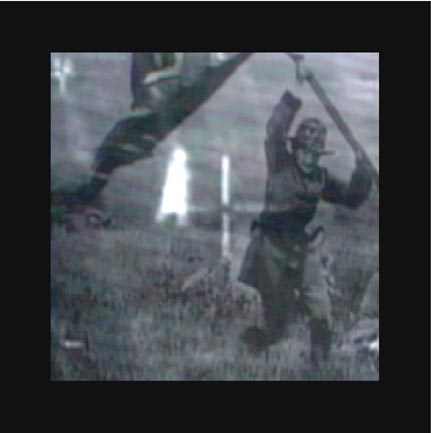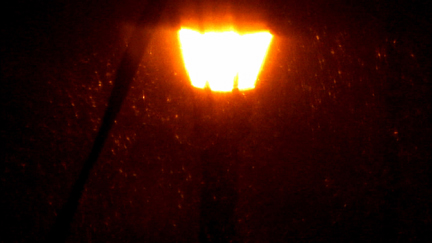Art and Sound, Bugs and Data
Michael Fallon visited the Sound in Art / Art in Sound show at the Minnesota Museum of American Art. Despite its shortfalls, theres some good things to see, hear, and think about in this show (through July 1).



Whenever a curator puts together an exhibition based on the concept of synesthesia, my hopes shoot sky-high. But as with most things in this world of sorrow, the final versions of these shows seldom fulfill their conceptual potential. Such is the case, alas, with the Minnesota Museum of American Art’s “Sound in Art / Art in Sound.” Even though it’s not a bad way to spend an afternoon, this show simply does not live up to the promise of its PR: “An auditory exploration of the power and nuance of sound.”
Synesthesia is a neurological condition in which two or more bodily senses are coupled. The mishmashy nature of this concept is a perfect draw for artists of the current moment, a number of whom seem enamored with bricolage, or a sort of handyman’s making of things out of scraps.
If recent exhibitions are any gauge, mixing visual art with other senses is more and more appealing to these bricoleur artists. Last fall, the Visual Art Center at the Massachusetts Institute of Technology presented “Sensorium: Embodied Experience, Technology, and Contemporary Art,” in which artists presented Scratch-N-Sniff wall art; a “touch-tunnel” filled with darkness, sounds, and a strobe light; and a Bruce Nauman work that claimed to “attempt to ‘see the night’ [by propelling] the viewer through a tumultuous journey that challenges vision’s dominance of vision over the other senses.” In recent years I have seen synesthetic shows about tactility, about art as food (or food as art), and three or four shows that are, like this one, ostensibly about art and sound.
It’s logical that this last type is popular. Visual art has long been connected with sound. Sir Isaac Newton, who examined the physics of color for his work Opticks, believed that color was an analogous phenomenon to sound. In “The Vibrations of the Air,” he wrote of light rays that travel through space and “according to their several bignesses, excite sensations of several sounds.” Seeing and hearing are the senses that help us navigate through space, so it follows that contemporary artists would recognize the connection between these senses. We position ourselves in space by simultaneously seeing the space around us and hearing what occupies that space. (The sense of smell, taste, and touch, on the other hand, are localized and internal, predicated not by space but by our contact with a specific object.)
All of us recognize the connection between sight and hearing on a subconscious level. After all, we often mix the senses in everyday language: “I see what you’re saying”; “that’s a really loud shirt”; “I’m seeing red about what you said.” This sensory mixture is so commonplace that few of us likely ever stop to wonder if the “blues” really do sound “blue,” or if Phil Spector really did create a “wall of sound” when he produced his records.
What’s disappointing to me about these shows is that they don’t truly, despite their claims, examine the nature of human senses—how we relate to the world through them, how we interact with them, how we construct our language in relation to this interaction, and so on. Instead, these shows almost always end up being primarily about the technological innovations of the time that allow artists to present better and more realized sound-image interactions. This, while not uninteresting to look at and hear, is not that intriguing to think about.
A key work in “Sound in Art / Art in Sound” perfectly demonstrates this let-down. “Urban Echo” is a sound and video-projection work by composer J. Anthony Allen and artist Christopher Baker. What we see in the gallery is a constantly shuffling deck of projected black-white images—GPS-type maps, atmospheric light flashes, and written text. Next to the projected imagery, an earphone device emerges from the wall (a key feature of most of the work in this show), and next to that there’s a didactic explaining what’s going on. On the earphones, what you hear is atmospheric electronic music, some buzzing sounds, and random distant voices who have been instructed to call a phone-answering service and answer two open-ended questions: “What do you hear? What do you want others to hear?” The resulting comments range, as you might expect from such a social-interaction experiment, from the deadpan literal (“I hear wind chimes on the back porch”) to more philosophical (“I hear the truth,” “I hear rainbows”). As you hear these scratchy, distant comments, you can see similar comments sent via an email address (along with the sender’s ZIP code, per instructions) to the artist, who then posts the words on screen, followed by a GPS map of where the comments originated from.
All of this is about as fun to look at as the typical Myspace page. The conceptual basis of this work isn’t, as advertised, much about sound. It’s more about how the technological tools in the work—the Internet, email, phone recorders, GPS systems, DVD projectors, sound recording devices—are being deployed, which means while this work is novel, it’s not particularly deep. In fact, this is true of the bulk of the work in this show, which playfully makes use of readily available technological devices–MP3 players, wireless earphones, ProTools or similar sound editing programs, digital video players and editors—all of which make it easy to disseminate sounds and connect them to images. The question of whether these are sounds we actually want to hear and ponder never seems to come up.
Mike Hallenbeck’s “Sound Spandrell” is nothing but an MP3 player attached to the wall (with headphones) that plays a loop track of industrial-sounding noises. A note on the work explains these sounds come from a recording the artist made on a visit to the empty gallery space at MMAA and enhanced using electronic filters that bring to light frequencies and sounds that would otherwise stay on the margins of perception. The result is interesting but unpoetic, rather like being in a Laundromat at night. Several other artists perform much the same feats, most notably Abinadi Meza with a close recording (and attached video footage) of a snowstorm in his work “Night Beacon,” and Anne Wallace with a diverse collection of random rural noises in her MP3 recording “Soundscape.”
The bricoleur impulse of these artists is evident further in artists who make use of sound and image found on the Internet and other such sources. Matthew Garrison’s “Autorange” collages footage from old public-domain movies that depict battle scenes and matches these video images with a pastiche of found sounds—recorded explosions that are slowed down to make a constant background rumble, snippet descriptions of military transmissions of military actions, and so on. Cheryl Wilgren Clyne’s video wall projection “Three” includes repetitive found images, such as a bicycle wheel that merges with a baby’s face, along with a similar accretion of sounds. None of these would be possible without modern technology, but beyond this point of interest none of them are particularly new or innovative in terms of concept or execution.
Fortunately, one of the works in this show does begin to fulfill the show’s promise to explore the nature of sound and hearing. “Green” by Shawn Decker, the single best work in this show, fills the entire entry room. On four hanging spans of plexiglass are mounted eight super-modern-looking half-inch speakers. Each of the speaker-spans is controlled by a custom-designed microprocessor that is attached to electromagnetic and light sensors. The processors record changes in light and radiation levels and create small impulses in the controller boards that cause the speakers to turn on and off very quickly. The resulting series of clicks and buzzes from the spans of speakers seems very random in the way of insect chirps in a field. It is also very mesmerizing to stand amidst, especially if you close your eyes, let yourself think of sounds in a pasture outside of Bemidji, and then examine what sorts of emotional responses occur in you because of this completely and transparently artificial transfer. What’s most interesting, and most question-raising, is the fact that the chirps and buzzes in “Green” aren’t random at all. They are the result of complicated calculations based on external stimuli. This, of course, is true of a field of insects as well.
In the end, “Green” at last raises the sorts of questions I wanted to have raised—about the nature of sound, senses, and our responses to stimuli. Through this work, I can ponder whether living creatures are nothing more than a conditioned series of responses, and I can ask what is the nature of life if it’s possible to replicate such responses through artificial (electronic) means. What does it mean philosophically that our senses can be broken down to a series of formulae, and what actual significance do our emotional reactions have if they can be reduced to mere responses to stimulus? In the end, by raising the level of inquiry about sound, senses, and the nature of life, “Green” makes it worth it to visit “Art in Sound / Sound in Art.” The show also includes works by Helena Keefe, Jack Pavlik, and Leif Brush.